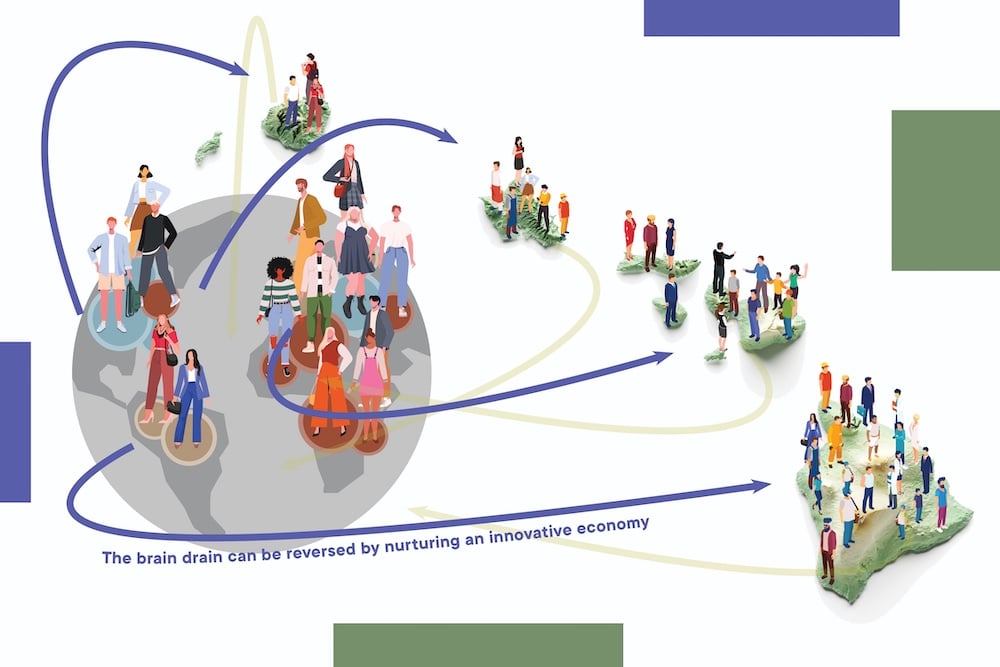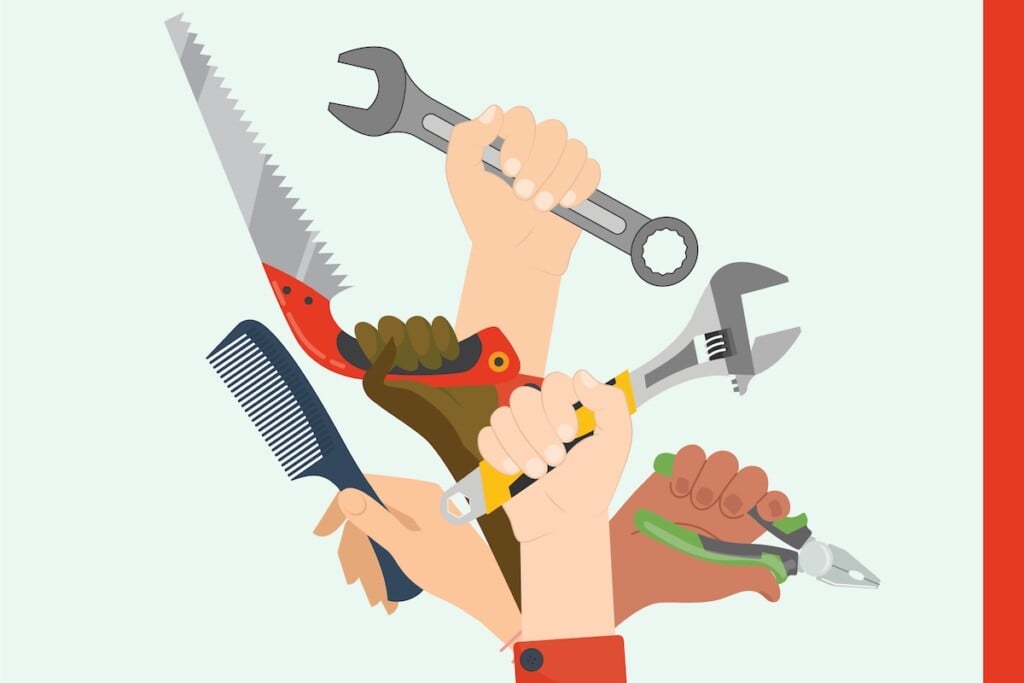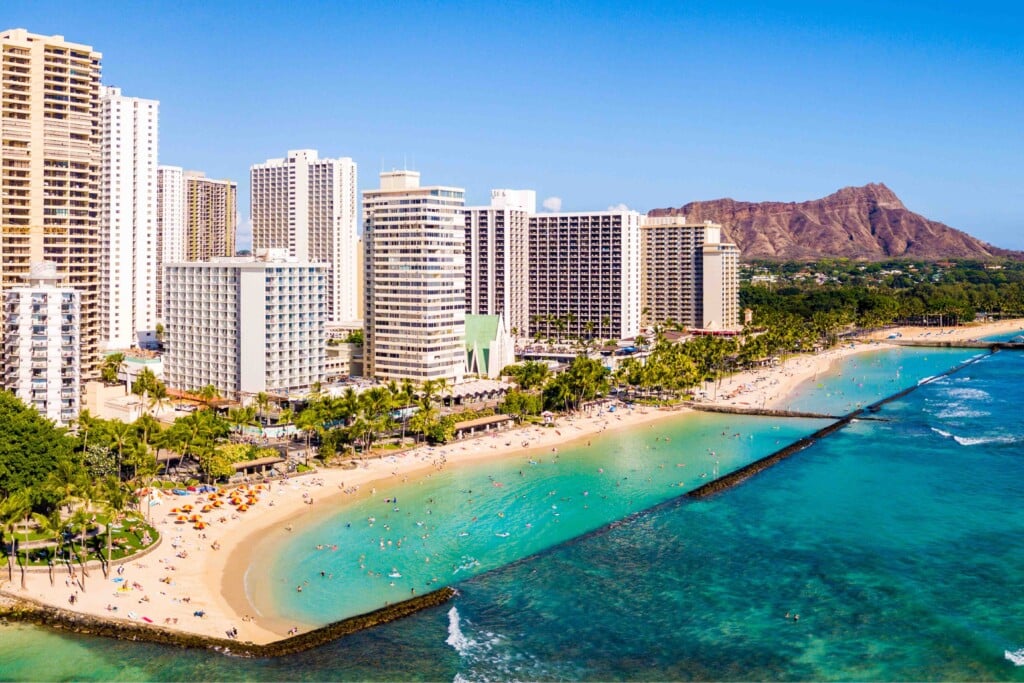A Roadmap to Revive Hawai‘i’s Economy and Future
Two local leaders argue that an effective combination of human capital, infrastructure and policy can create a growth economy that benefits everyone.

Hawai‘i’s stagnant population, lack of good-paying jobs and anemic economic growth pose existential threats to our people and our way of life. This paper, “Hawai‘i – Finding the Future,” examines how we create economic growth and build an inclusive future, and what is needed to make this happen.
The authors come from different backgrounds. But each has decades of experience, both locally and across the world, and each cares deeply about Hawai‘i and agrees it is on a troubling trajectory. The two of us also believe the people of Hawai‘i can change that trajectory if we effectively organize human capital, infrastructure and policy. If we paddle together, we can grow the economy, create lots of good-paying jobs and reverse the out-migration of our children.
The first paper we wrote, “Hawaii – Losing the Future?” (tinyurl.com/HiFuture), pointed to the need for human capital formation, which means increasing knowledge and skills – essentially investing in people to enhance their productivity. When Hawai‘i’s enhanced human capital is combined with the right policies and support systems, economic growth will accelerate.
This paper reframes the central theme of Hawai‘i’s economy for more than two centuries: We need to pivot from thinking that we create prosperity by picking winners – think sandalwood to sugar and pineapple to tourism – and instead grow the economy by creating a business-friendly environment that enables rapidly evolving innovation, technology opportunities and companies that address global needs – whatever the industry or sector.
Traditional neoclassical economic models based on endowments of labor, natural resources, and physical capital formation reflect factors that drove Hawai‘i’s economic growth in the past. We argue that future opportunities must come from economic growth models that rely on human capital, entrepreneurship, research, development and innovation, which are the core ingredients of today’s sustainable, high-growth economies.
The basic elements needed to grow the economy are already here: leading-edge university research is creating technological breakthroughs; the university graduates are amazing; and the business community is interested and engaged. And it’s all happening in a desirable location.
With a few policy tweaks to supercharge the university and cultivate a supportive and nurturing business climate, Hawai‘i could generate new companies and industries that address global opportunities with well-paying jobs and huge ripple effects throughout the local economy. Although this sounds straightforward, it’s difficult to execute and requires big commitments and changes in mindsets.
The destruction of Lahaina made it impossible to keep ignoring the economic obstacles that Hawai‘i faces. All of our concerns for the future of Hawai‘i’s economy are further exacerbated by the second Trump administration’s tariffs, disintegration of federal programs, and support for research and development in higher education. These policies undermine what most of the world considers as America’s crown jewel: university research and the development of human capital. These federal dollars have been a huge driver of Hawai‘i’s economy since the 1940s, further underscoring Hawai‘i’s economic brittleness and the need for diversification and growth opportunities. Perhaps with all this chaos, now is the time for change to grow Hawai‘i’s economy.
Why “Social Capital” Has Declined
Poor economic growth creates a lack of opportunity that manifests itself in many ways, including out-migration, growing economic disparities and unaffordable housing. It results in declining social capital – networks where people can rely on each other and work together toward shared goals. Social capital is built on community trust and positive relationships within a community or network; it fosters reciprocity and cooperation among individuals. When social capital is low, it is difficult to try new things.
Well-functioning institutions, which effectively manage social capital, are critical for economic prosperity, as articulated by Daron Acemoglu, Simon Johnson and James Robinson, winners of the 2024 Nobel Memorial Prize in Economics. When institutions work, economies prosper because people, businesses and institutions share trust.
In 2012, the need to diversify Hawai‘i’s economy was discussed at the “Building Hawaii’s Innovation Economy” symposium hosted by the U.S. National Research Council Committee on Competing in the 21st Century. In the symposium report, Carl Bonham of UHERO, the UH Economic Research Organization, reviewed the Islands’ history of economic dependence on a series of single products. Two centuries ago it was sandalwood, then whaling, sugar and pineapple, the military and now tourism.
“While the state will certainly continue to benefit from visitor-based revenues and military spending, the challenge for this century,” Bonham’s summary concludes, “is to develop the multi-sector, interdisciplinary capacities needed to generate S&T-based (science and technology) innovation and diversify the state’s opportunities for economic growth.”
Twelve years later, UHERO invited discussion with a preliminary blog post entitled “Potential Opportunities to Diversify the Economy of Hawaii” (July 2, 2024, tinyurl.com/Hinext) that suggested recommendations on diversifying Hawai‘i’s economy focusing on location-based industries like finfish and shellfish fishing, boatbuilding, port and harbor operations, finfish farming and hatcheries, and seafood preparation and packaging.
UHERO’s paper was based on the idea that regions are likely to enter or exit economic activities based on the number of related activities in that location – a location-based approach to economic growth. While we believe this can retrospectively provide insights on why an industry emerged, it is less helpful in understanding where future growth opportunities exist. For example, Venice had a trade of fish and salt before it diversified into commerce more broadly, and into finance, supply chain management, technology and tourism.
An Environment for Great Ideas
In summer 2024, as it had for nearly 40 years, Oceanit conducted its Summer Intern Program, mostly for STEM undergraduate and graduate students. It exposes these students to “how we think” at Oceanit; in return Oceanit asks the students to share their internship experiences with their families and teachers.
Over 700 interns have gone through this program. Oceanit now accepts 12-14 interns each summer, out of 1,000-2,000 applicants. Most either grew up in Hawai‘i or have connections to the Islands. At the end of the summer the interns present an innovation “to make the world a better place,” one of their choosing. They must present their case in five slides over five minutes and answer questions from the audience for five minutes. We invite businesspeople, parents, university administrators and legislators.
A range of great ideas was presented last summer, including developing space-based fuel from orbital debris, forging a new reading technology for the blind and creating an energy efficient computational framework for energy hungry AI systems like ChatGPT.
An interesting question was posed by the audience: “Where do these ideas come from?” The answer: from the minds of these young people. But it takes the right environment for those ideas to emerge. The audience’s question was couched in the idea that many UH students focus on “location-based” innovations like T-shirt shops or carving cool designs from coconuts. The concern is that these students don’t reach outside what they see in front of them and are not exposed to thinking about high growth or high impact ideas that are geographically untethered.
In contrast, Oceanit interns are asked to consider a broad-based philosophic objective: “Propose something to make the world a better place.” That is the only guideline. It is not limited by subject or geography. Oceanit commits to helping the interns find experts in just about any field so they can have conversations or ask for assistance on anything they could imagine.
We know young people are very interested in being part of something impactful. They are not lazy or afraid, given the opportunity.
Contrast this with the suggestion coming out of the UHERO blog post that focuses on diversifying Hawai‘i’s economy with fishing and other geographically based industries. While we appreciate the rigor and methodology deployed by UHERO’s team, we believe this method misses key drivers to growth opportunities – like when human capital collides with research breakthroughs that impact humans and society. This combination, occurring in a supportive business environment, rides the waves of rapidly evolving science and technology and creates explosive growth and lots of good-paying jobs.
The Wrong Question
When Patrick Sullivan was asked to speak to a group of emerging business leaders, the key question audience members wanted to explore was: “What industry should Hawai‘i focus on?” This is historically a very common question in Hawai‘i. However, it is the wrong question.
The biggest new economic opportunities today originate from educated people and innovation. Technology changes rapidly and the rate of innovation is increasing, rapidly creating new opportunities. What was once impossible, becomes possible with advances in science, chemistry, materials, AI and other breakthroughs.
The strategy of “picking” technology or industries is flawed because new tools, methods and techniques are constantly supplanting old ones. Instead, an environment that supports innovation will lead to economic growth and often unforeseeable innovation jobs that have large economic multipliers.
Future Considerations and Recommendations
To be clear, bringing back tourism is essential to Hawai‘i’s economy. It provides a platform to create economic growth. New growth will come from creating, building and growing companies.
At a high level, the ideas around this are simple to understand but hard to execute. Startup investing is a numbers game: One needs to consider investing in 100 big ideas where perhaps one or two become unicorns with a market cap of over $1 billion. The other 98 or 99 that become middling enterprises, underperforming companies or failures are financially inconsequential compared to one unicorn.
However, to achieve one unicorn, one needs to consider 100 or even 1,000 opportunities that all swing for the fences – very big, very disruptive ideas, typically driven by breakthroughs in science or engineering. This “deal flow” makes venture investing work.
Universities are a critical part of the economic growth engine: They need to produce many hundreds of graduates in science and engineering every year. Keeping this talent and the related high-quality jobs in Hawai‘i requires creating many startups and sustaining their growth in a supportive business ecosystem.
In an ideal world, this supportive business ecosystem already exists. It could be anywhere – Silicon Valley, Israel, Boston or Hawai‘i. However, when the business ecosystem is underdeveloped, policies can help nurture the right business environment.
Think about this metaphorically: Imagine a startup entrepreneur as an explorer with an 80-pound pack, then picture them trekking 100 miles up a steep mountain while wearing surf shorts. Entrepreneurs are unprepared for such a journey – which includes freezing temperatures, wild animals and bandits – but most are confident they will “figure it out” along the way. Sadly, most new businesses fail in the first few years.
When policies are in place to support these entrepreneurs, it’s metaphorically like providing a decent pair of boots or fuel at the next campsite. Even small gestures of support lighten the load and reduce risk, increasing the likelihood the entrepreneur will reach the summit. Policies can enable companies to stay in Hawai‘i, compete and thrive.
The role of a university is different from what many expect. From our perspective, the most important role is to produce quality people – human capital. This includes creative and fearless graduates, as well as highly skilled Ph.D. scientists and engineers who have produced technical papers and dissertations to be proud of.
However, the expectation that universities unilaterally produce economic growth is misplaced. Universities are an awesome environment to train thinkers from all fields, but industry has little regard for the number of journal citations in your resume.
An article in the Feb. 5, 2024, issue of The Economist, titled “Universities are failing to boost economic growth,” got it right. Major economic growth comes from high-quality graduates working in industry, industrial labs and the private sector where their academic interests are tempered with practical realities, like “payroll every two weeks.” The graduates, in turn, need to understand how to contribute to the puzzle of creating impact and value from innovation.
In Hawai‘i, the example of astronomy and Maunakea is instructive. Whereas UH’s Institute for Astronomy is best of class and produces excellent research, the belief is misplaced that it would produce thousands of jobs in the private sector and deliver economic growth. The institute has produced numerous citations in highly regarded journals, but it has been less notable engaging with the community in meaningful ways. For example, it hasn’t created or sustained significant business opportunities in support of astronomy.
The same could be argued for UH’s tropical agriculture program. In the early 1970s, the program developed a super strain of corn known for its sweet flavor and resistance to diseases and pests, which feeds the world today. But related business opportunities were not created and sustained in Hawai‘i.
These were lost opportunities, but if Hawai‘i develops a more supportive and holistic business environment, the community can benefit from future opportunities that its young people produce through excellent research and training at UH.
Depopulation Spirals Are Hard to Reverse
Over the years, numerous innovative startups have emerged in Hawai‘i, only to move to the mainland. Why do they leave? The most common reason is better access to capital. Although there is abundant capital in Hawai‘i, it does not go to early-stage ventures or tech companies. Hawai‘i has not been ready for innovative startups, does very little to sustain them and overall has been uninterested in them.
This is as much a social-political issue as a capital and infrastructure issue. We believe things can change, but it will take a concerted effort from all of Hawai‘i, including policymakers, businesses and educators. The establishment of “deal flow” in a positive business environment will attract capital and create companies and high-paying jobs.
A host of policy ideas could help “lighten the load” and grow Hawai‘i’s economy. The graphic titled Policy Ecosystem Framework is intended to narrow the focus but is not an exhaustive list. However, we believe the policies outlined in the chart and below could nurture a diverse and supportive business ecosystem, enabling entrepreneurs with interests in disruptive innovation to launch, sustain and grow businesses, create jobs and thrive in Hawai‘i.
The key consideration for Hawai‘i is to decide if economic growth is important enough to experiment with new policies at the risk of making mistakes along the way. If we decide that growing the economy, creating a more resilient economy, and producing well-paying jobs for Island residents is important enough, there are many ways to make that happen.
This framework, although basic, illustrates the abundance of policy ideas and opportunities that could deliver a more business friendly environment. Each policy idea is an expression of Hawai‘i’s interest in change – taking a policy risk to have a positive impact.
Rather than focus on a specific opportunity – such as artificial intelligence, semiconductors, quantum computing or edge manufacturing – focus on the fundamentals that lead to a supportive business ecosystem that enables startups and sustains and grows companies.
Developing human capital – smart, educated people – continues to be table stakes for a successful business. Whereas the kinds, qualities and skills vary, every business needs strong talent. That said, the majority of big, impactful startup opportunities are expected in technical fields driven by breakthroughs in engineering, physics, math, chemistry, computer science and other STEM-related disciplines.
Startups need entrepreneurs who have the ability to tolerate risks that most people will never understand – we call them “roller-coaster riders.” However, without a solid team, the best entrepreneurs flounder. We also need financial managers, product designers, office managers, scientists, engineers and more, otherwise great ideas wither and fail to mature.
Infrastructure policies can deliver a nurturing environment, enabling business development and growth. Hard infrastructure – including capital, equipment, facilities and supportive utilities – enables businesses to operate. Soft infrastructure – including networking, marketing and branding – enables businesses to thrive and grow. Together, hard and soft infrastructure can fashion a business environment where great ideas can develop and thrive in Hawai‘i.
Our challenges are not geographically limited but self-imposed. Once they are dismissed, national and international markets will open. Examples of policy ideas include the following.
Driver of Innovation: Human Capital
People are the essential ingredient to building Hawai‘i’s future businesses. Students in K-12 who are exposed to ideas and potential opportunities are more likely to search out related educational opportunities. Skills beget skills. Policy ideas for consideration that help build human capital include:
-
Supercharge UH STEM Education: Invest in capabilities and encourage undergraduate and graduate education in the STEM fields, such as physics, engineering, math, chemistry, computer science, molecular biology and genetics. Encourage researchers to pursue big, bold ideas that, if successful, could impact humans and society. For example, consider areas like quantum computing, dark matter, climate engineering, space travel and exploration, human disease and longevity, new energies and artificial general intelligence.
This partial list is incomplete and possible areas continuously evolve. The one certainty, however, is that the world’s most important problems bring new opportunities.
Many great examples of how this works are everywhere, including in the engineering program at the University of Colorado, Boulder. It hosts close to 1,000 doctoral students who produced 22 of the 35 new startups to come out of that university last year. These new companies plus already established companies spun out of the university attracted roughly $500 million in new investment capital last year.
If one considers only engineering, using University of Colorado numbers, roughly 2% of Ph.D. research creates new investable disruptive opportunities that attract new capital. To create a good number of investment opportunities, one could argue that UH needs to build a major engineering program pursuing hundreds of disruptive new Ph.D. research endeavors across numerous disciplines.
-
University Connectivity: To reduce the risk of another community confrontation like the one at Maunakea, adopt a UH program that hires local research and development companies to support 10% of UH’s R&D spending.
-
Research Competitiveness Support: Innovation is a competition of ideas and we need to support the “Hawai‘i team” of locally based R&D companies.
-
An R&D tax credit or matching grant to match a percentage of R&D performed in Hawai‘i would help local companies compete. Such programs would focus on Hawai‘i-based small businesses engaged in qualified R&D.
-
A Small Business Innovation Research match. SBIRs are nationally competed. The probability of winning a Phase I SBIR grant is roughly 10%: write ten, lose nine, win one. Hawai‘i should support local companies applying for SBIR grants and celebrate those who win.
-
Driver of Innovation: Hard Infrastructure
Infrastructure can include both hard infrastructures – capital formation, buildings and equipment – as well as supportive infrastructure like affordable electricity, broadband and transportation. Examples of hard infrastructure include:
-
Venture Capital: Develop capital markets in Hawai‘i by launching a half-dozen new locally based venture capital funds, mimicking the findings from a 2002 study by Grove Street Advisors called “The Case for Investing with New and Emerging Private Equity Fund Managers.” This would require a percentage of Hawai‘i’s state retirement fund alternative asset class to be allocated in venture capital investing, particularly with untested or fresh entrants.
When Hawai‘i provides a more supportive business environment, it will encourage the world’s wealthiest technology founders (some of whom have homes in Hawai‘i) to allocate part of their vast investment funds in Hawai‘i-based venture capital and private equity investing.
And since successful venture investing requires large numbers, there needs to be many ventures to invest in, including abundant opportunities from places like UH. Nurturing engineering students and Ph.D. graduates in STEM fields will feed successful venture investing.
-
Technology Commons: This means shared equipment, spaces and facilities – including access to clean rooms and manufacturing infrastructure. For companies that require equipment and instrumentation, the state government could underwrite partial funding for a Hawai‘i Instrument Pool, ensuring the equipment is later available to other scientists, engineers and technology developers. Examples of this equipment include oscilloscopes, digital voltmeters and lock-in amplifiers.
-
Connectivity to the West Coast: Create special bulk commercial passenger and freight rates on major air carriers to connect Hawai‘i tech businesses to the West Coast.
-
Utilities: Discounted pricing on electricity for equipment and facilities could include a price of 10 cents per kilowatt-hour for laboratory equipment used to support R&D and the development of technology. This policy mimics a Honolulu County water pricing policy that gives discounted prices for agricultural uses, to support and encourage agriculture.
-
Affordable and Timely Construction: Create a “shot clock” for permitting of new construction and renovations. There is no reason it should take three years to acquire a building permit to renovate an office space, particularly when the tenant seeking the permit has occupied the same space for the last decade.
The same could be said for housing, which continues to be a problem across Hawai‘i. Demand timely and quality performance from local institutions that manage all construction. This would reduce the overall cost of construction.
Driver of Innovation: Soft Infrastructure
Hawai‘i is a powerful brand recognized around the world. Build on Hawai‘i’s brand to support global connectivity and collaboration with introductions to organizations in national and international markets, including the following:
-
Industry Connectivity Through Hawai‘i Marketing and Branding: Technology industries all have their key conferences and industrial events. If Hawai‘i-based technology developers attend these meetings, Hawai‘i’s brand could make it easier for them to connect with industry leaders and financiers. Support for local developers could include sharing the cost of attending these conferences.
-
Hawai‘i Early Adopter Participation: Locally based companies that develop or produce technology should have preference in Hawai‘i government purchasing as “early adopter” customers. Although developing criteria for this is complicated, starting close to home, using feedback from the community and other factors can make a big difference as technology moves to bigger national and global markets.
Change Is Essential
Most businesses in Hawai‘i agree the climate here is anti-business. It does not have to be this way. Fixing the business environment requires revisiting policies and creating new ones to support opportunities – making Hawai‘i’s institutions more likely to say “yes” to a business.
However, good policy is difficult to create. Effective policy to support economic development and growth is difficult to create, too – every idea that attempts to create economic opportunity simultaneously generates risk of abuse. The public has a long memory of what didn’t work, which can overshadow attempts to try something new. This lack of confidence produces institutions that say “no.” While this is understandable, it harms communities in the long run.
One great example of policy that created economic growth came in 1982 when President Reagan signed the Small Business Innovation Development Act into law. It required all federal agencies to set aside about 3% of their funding to support small businesses in all 50 states. The only requirement is that the business is a “small business,” which generally means less than 500 employees.
The premise of the program is that small teams are where innovation lives. For innovators, it’s essentially a nationwide intellectual cage match: only 1 in 10 walks out of the cage. However, this has supercharged economic growth in all 50 states and has resulted in the development and growth of companies in every field.
Those that make it to the “ultimate cage match” eventually compete for billion-dollar federal programs. Successful techno-warriors learn to compete against the very best minds across the U.S. When these companies operate in supportive business ecosystems, they rapidly expand – creating lots of high paying jobs.
For Hawai‘i, we have fundamentally two options: Continue on the same path or try something new. If we continue on the same path, all trends indicate Hawai‘i’s economy will get worse – declining GDP, out-migration, growing social and economic inequality and more. We believe the correct choice is simple: Bet on Hawai‘i’s people and take a chance on new ideas and policies.
Patrick Sullivan, Ph.D., is the founder and CEO of Oceanit. Paul Brewbaker, Ph.D., is the principal of TZ Economics and the former chief economist at Bank of Hawai‘i.








